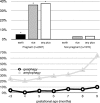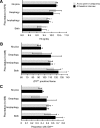Association of pica with anemia and gastrointestinal distress among pregnant women in Zanzibar, Tanzania
- PMID: 20595493
- PMCID: PMC2912591
- DOI: 10.4269/ajtmh.2010.09-0442
Association of pica with anemia and gastrointestinal distress among pregnant women in Zanzibar, Tanzania
Abstract
The etiology of pica, the purposive consumption of non-food substances, is not understood, despite its ubiquity among gravidae. We examined correlates of pica in a representative obstetric population (n = 2,368) on Pemba Island, Zanzibar, Tanzania to examine proposed etiologies. Cross-sectional data were collected on socioeconomic characteristics, food intake, geophagy (earth consumption), amylophagy (raw starch consumption), anthropometry, iron status, parasitic burden, and gastrointestinal morbidities. Amylophagy was reported by 36.3%, geophagy by 5.2%, and any pica by 40.1%. There was a strong additive relationship of geophagy and amylophagy with lower hemoglobin (Hb) concentration and iron deficiency anemia. By multivariate logistic regression, any pica was associated with Hb level (odds ratio [OR] = 0.76, 95% confidence interval [CI] = 0.72-0.81), nausea (OR = 1.45, 95% CI = 1.20-1.73), and abdominal pain (OR = 1.22, 95% CI = 1.01-1.48). These striking results indicate that the nature of the relationship between pica, pregnancy, gastrointestinal distress, and iron deficiency anemia merits further investigation.
Conflict of interest statement
Disclosure: None of the authors have any conflicts of interest.
Figures


References
-
- Laufer B. Geophagy 18(2) Chicago: Field Museum of Natural History; 1930.
-
- Danford D. Pica and nutrition. Annu Rev Nutr. 1982;2:303–322. - PubMed
-
- Jenkins CL. Geophagy in Fayette county, Tennessee: a symbolic interpretation. Tennessee Anthropologist. 1980;5:73–91.
-
- Krishnamani R, Mahaney W. Geophagy among primates: adaptive significance and ecological consequences. Anim Behav. 2000;59:899–915. - PubMed
Publication types
MeSH terms
Substances
Grants and funding
LinkOut - more resources
Full Text Sources
Medical

